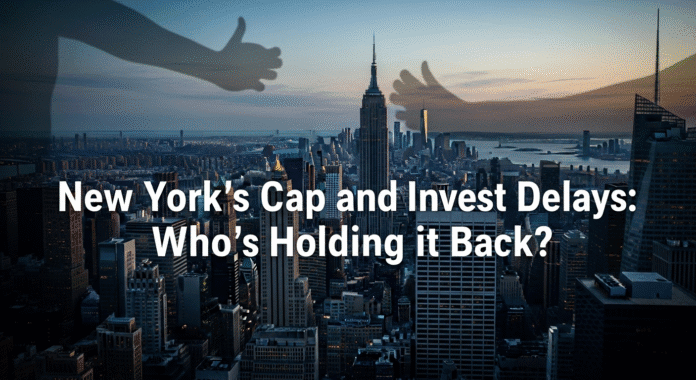Delays and Debate: Who’s Holding Up New York’s Landmark “Cap and Invest” Program?
By David LaGuerre-
Six years after New York passed one of the nation’s most ambitious climate laws, the long-awaited “cap and invest” program remains unrealized. This stalled initiative, designed to reduce greenhouse gas emissions, improve air quality, and generate revenue for essential clean energy investments, now faces complex regulatory hurdles, affordability concerns, and mixed public reactions. In this post, we explore the intricate web of factors and decisions that are delaying its launch, while also highlighting the voices of those both critical of and committed to realizing the program’s promise.
The Promise Behind the Program
New York’s “cap and invest” strategy was born from the Climate Leadership and Community Protection Act (CLCPA), a groundbreaking law aimed at reducing greenhouse gas emissions by 40 percent by 2030 and 85 percent by 2050 (relative to 1990 levels). The program intends to set a declining cap on emissions from large polluters. Companies will be required to purchase allowances for each ton of CO₂ and other pollutants they release. Revenues from these auctions are slated to support clean energy projects, energy efficiency programs, and direct rebates to households, particularly in disadvantaged communities.
By linking an emissions cap with targeted investments, the program was designed to tackle multiple challenges simultaneously: meeting aggressive climate targets, improving local air quality, and fueling an economic transition to a greener future.
Regulatory Hurdles and Official Explanations
The delay in launching the “cap and invest” program is primarily attributed to the intricate regulatory framework needed to balance environmental goals with economic realities. State agencies, including the New York State Department of Environmental Conservation (DEC) and the New York State Energy Research and Development Authority (NYSERDA), are painstakingly crafting the rules to ensure the program is both effective and equitable.
Governor Kathy Hochul has emphasized that the delay is about getting the details right. In her 2025 address, she stressed the need for “more space and time for public transparency” to build a program that meets the state’s lofty goals without hurting families. She explained, “We must ensure that this program does not disproportionately burden New Yorkers, especially low-income households.”
Both DEC and NYSERDA are deep in the planning stages. DEC Commissioner Basil Seggos noted, “New York State is developing a cap-and-invest program to effectively reduce climate pollution while advancing environmental, public health, and economic benefits to communities.” Meanwhile, Doreen M. Harris, NYSERDA President and CEO, reiterated that gathering stakeholder input and refining investment strategies are crucial steps. Their cautious progress reflects a broader effort to design a system that can withstand legal, economic, and political scrutiny.
Key Voices: Who’s Influencing the Process?
The discourse around the cap-and-invest program has drawn contributions from various political figures, environmental advocates, and industry stakeholders. Their perspectives offer a window into the competing priorities shaping New York’s climate policy.
Delaying Figures and Their Concerns
Governor Kathy Hochul sits at the center of the debate. Her administration has repeatedly postponed the program’s launch, citing concerns over affordability and the need for robust public consultation. Hochul’s repeated call for caution – “get it right” – underscores a determination not to rush into untested regulatory frameworks that might put an undue financial burden on New Yorkers.
Beyond the executive branch, some business groups have voiced their opposition. Industry representatives warn that strict emissions caps might raise operating costs, rendering New York less competitive. Critics argue that even a modest increase in costs for polluting companies could ripple through the economy, potentially affecting jobs and consumer prices. Assemblymember Claire Valdez encapsulated this frustration at a recent rally, asserting, “We need action now, not more excuses. New Yorkers deserve a government that prioritizes their health and future.”
Voices of Support and Advocacy
Support for the program is robust among environmental advocates and some state agencies. DEC Commissioner Basil Seggos and NYSERDA President Doreen M. Harris have both characterized the initiative as a “critical tool to achieve New York’s ambitious climate goals.” They stress that while the current delay is challenging, careful calibration now can ensure long-term benefits, including cleaner air and stronger community resilience.
Environmental advocates, such as Stephan Edel from NY Renews, have voiced a mixture of impatience and caution. Edel remarked, “It’s frustrating how little we’ve heard from the governor on a program that would benefit residents statewide.” Meanwhile, Vanessa Fajans-Turner from Environmental Advocates NY noted, “This reporting rule is progress… But we have to be honest with ourselves: knowing who’s polluting doesn’t stop the pollution.” Such statements capture the tension between the urgency demanded by environmental justice advocates and the procedural delays insisted upon by policymakers.
The debate extends to labor unions as well. While some unions fear job losses in traditional energy sectors, others see the potential for job creation in renewable energy and energy efficiency initiatives. Proponents insist that any transition must be managed with robust retraining and job protection measures.
Economic and Environmental Stakes
New York’s cap-and-invest approach is a multifaceted policy aiming to generate significant environmental and economic benefits, albeit with its share of trade-offs.
Revenue Generation and Economic Impact
Projections estimate that the program could generate between $6 billion and $12 billion per year from the auctioning of carbon allowances. These funds are earmarked for investments in clean energy technology, home energy efficiency improvements, and direct consumer rebates. By tying revenue to emissions, the program is engineered to create a self-sustaining cycle of environmental improvement and economic support. Critics, however, caution that even modest increases—such as an estimated $10 monthly uptick in energy costs for middle-income families—could strain household budgets. They assert that the balance between revenue generation and affordability is a razor-thin one.
Supporters counter that at least one-third of the generated revenue will directly benefit low-income households, offsetting potential energy price increases. This careful targeting of funds aims to protect vulnerable communities while spurring job creation in the green economy. Recent studies suggest that the program could create tens of thousands of jobs in sectors ranging from renewable energy to building retrofits, contributing to broader economic resilience.
Environmental Benefits and Emission Reductions
The cap-and-invest mechanism is designed to complement New York’s ambitious climate targets by ensuring that overall emissions decline steadily. Initial models predict a statewide reduction in greenhouse gases that could exceed 20% beyond current baselines by 2030. Moreover, by focusing additional investments on disadvantaged communities, the program seeks to alleviate longstanding environmental injustices. Reduced exposure to harmful pollutants could improve public health outcomes, particularly in areas that have historically borne the brunt of industrial pollution.
The program’s design incorporates mechanisms to prevent pollution hotspots. Environmental justice advocates insist on strong safeguards, such as facility-specific emissions caps and limits on the trading of allowances, to ensure that no community is left behind. They argue, “No cap and invest scheme can be effective without simultaneous action to close the polluting fossil fuel plants that are hurting frontline communities the most.”
Weighing Counterpoints and Diverse Perspectives
Critics of the cap-and-invest program offer a series of counterarguments justifying their skepticism about its near-term implementation.
Concerns from Business and Industry
Many industry observers emphasize that New York’s competitive edge might suffer if local businesses face significantly higher operating costs. Industry groups caution that stringent emissions limits could compel companies to relocate to states with more lenient environmental policies. This loss of business could have adverse economic effects, including job losses, decreased investment, and a slowdown in technology deployment.
Labor Union Perspectives
Labor unions present a nuanced view. While many appreciate the potential for job creation in the green sector, there is growing concern about the transition for workers in traditional energy fields. Unions representing fossil fuel workers have pointed out that without adequate retraining and job transition plans, the economic benefits might not reach those who need them most. The push for a “just transition” is a recurring theme in rallies and public statements, urging decision-makers to ensure that new green jobs provide competitive wages and benefits to offset any losses in legacy industries.
Political Opponents’ Critique
Political opponents across the ideological spectrum have set their sights on the delays. Some conservatives and moderates accuse the state government of bureaucratic overreach and inefficiency. They argue that the prolonged timeline undermines confidence in New York’s ability to meet its climate goals and leaves residents uncertain about future energy costs. The persistent delays have also provided fodder for critics who claim that the program, despite its noble objectives, is mired in red tape and political compromise.
Rebuttals and Forward-Looking Arguments
Supporters of the cap-and-invest program emphasize that the stakes are too high to allow a hasty rollout. They maintain that a carefully calibrated policy is essential to ensuring both environmental effectiveness and social equity. The potential for the program to transform New York’s economy toward a more sustainable future outweighs the short-term inconveniences of regulatory delays.
Furthermore, many point to successful models in states like California and Washington, arguing that while challenges exist, the benefits—such as reductions in harmful emissions and meaningful revenue streams that fuel green growth—are well worth addressing the complexities head-on. In balancing these perspectives, decision-makers must navigate a narrow pathway that prioritizes both robust climate action and economic stability.
Looking Ahead
The road to launching New York’s cap-and-invest program is strewn with challenges, political debates, and economic trade-offs. State agencies remain committed to forging a transparent, effective program that meets the state’s high environmental standards while protecting vulnerable communities. The goal is to hold the first allowance auction by late 2025, though uncertainties persist as regulatory details are finalized.
This juncture represents a critical moment not only for New York’s climate policy but also for the broader national conversation on managing climate change in a socially responsible way. The evolving debate underscores that progress is not a linear journey but a complex process of negotiation, evidence-based policymaking, and stakeholder engagement.
New Yorkers now face a pivotal decision: demand accountability and push for timely implementation, or accept further delays in the face of bureaucracy and uncertainty. As discussions in Albany continue, the need for a balanced approach—one that marries environmental urgency with economic pragmatism—has never been clearer.
Engage with this story by sharing your thoughts or leaving a comment below. Your voice matters in shaping the future of New York’s climate policy.
Hochul Announces $54M Project Completion for 103 Public Housing Units




